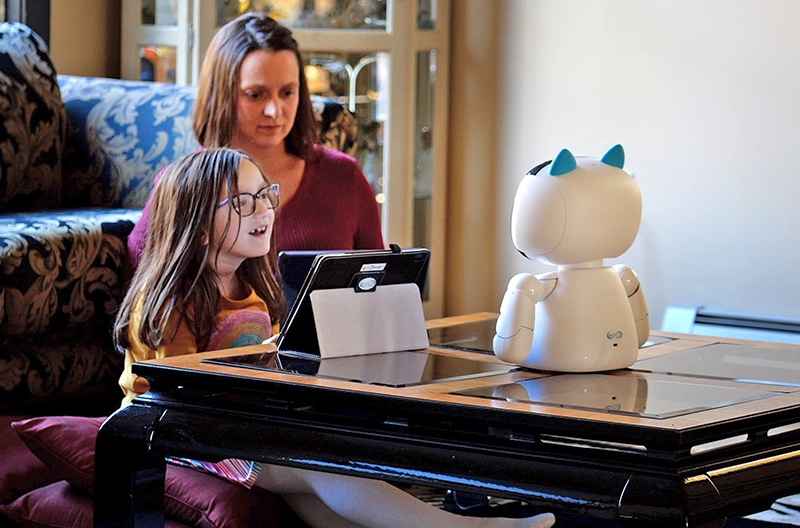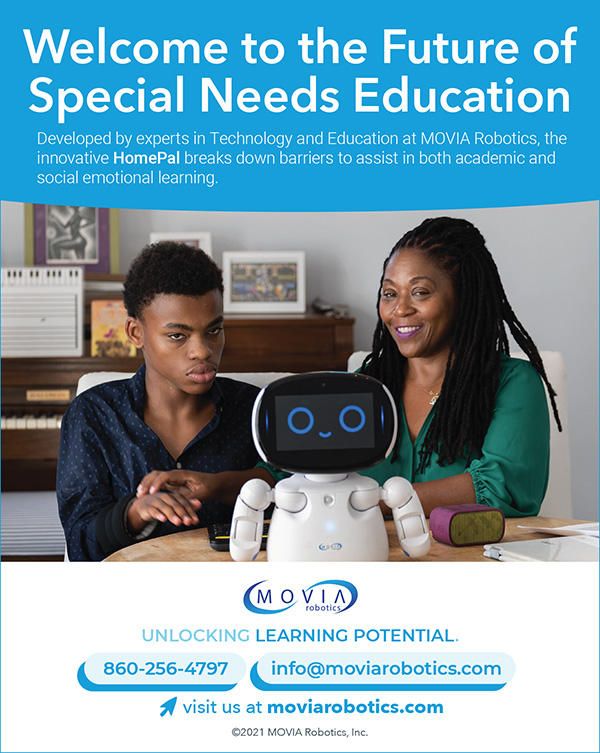Assistive Technology (AT) is an advancing field that helps individuals with special needs learn, grow, and participate in the community. These devices can take many forms and work at many levels. Robot-Assisted Intervention (RAI) is an advanced form of assisted technology. These tools can help the individual with special needs meet their educational or treatment goals. In RAI, the robot and other devices work together to support the individual’s learning and therapeutic experience by providing different levels of assistance depending on the activity. The facilitator and the RAI system form a team to provide a positive and effective intervention for the individual.

MOVIA Robotics use in the home to help the child meet their educational and treatment goals (credit: Maring Visuals)
RAI is very enjoyable and comforting for the individual. The robot is friendly and supportive, leading the child or adult through different activities that are designed to teach skills and provide opportunities to practice these skills. The robot can also provide therapeutic activities to help the individual. It can take many roles such as a friend, playmate, therapist, and teacher, switching between roles depending on the needs of the moment.
One of the main ways that RAI assists is through communication. The robot communicates on multiple levels. The system uses different technology to interact with individuals in specific ways that fit their preferred form of communication. It can provide supports for communicating visually, through speech, with gestures, singularly or in combinations. The RAI system can also provide any combination of assistance for an individual who needs help with receptive communication, expressive communication, or both.
Some individuals, for example, are not able to communicate verbally. For those individuals, the ability of the system to communicate visually through the tablet and through motions is very beneficial. Others have difficulties that slow their ability to either process incoming words or to form sentences and then communicate them. Some individuals cannot form speech but can understand speech from another person. These individuals have receptive communication. RAI can be tailored to each individual’s needs.
Verbal communications skills are vital to successful integration into modern society. The robot’s animated delivery of speech provides an engaging platform for verbal interactions with the individual. The RAI system is well suited to individuals with receptive communication. The system provides training and practice in understanding speech as well as with appropriate and expected responses.
The RAI system includes a powerful visual communication device in the form of a tablet that the individual can use to interact with the system. The tablet displays images showing the topics being taught. It also provides an opportunity to give the individual training and practice with fine motor tasks.
The movements of the robot provide another form of communication. The robots are semi-humanoid, enabling them to perform movements and gestures that are like those of a person. These movements are used during the robot’s speech to provide a more realistic experience for the individual. The robot and the individual can participate in coordinated movement games and activities. These coordinated movement interactions support social interactions and can also help the individual form a bond with the robot. When the individual attends to the gestures and timing of the robot, they are focusing on another entity separate from themselves. The other entity has a similar set of joints and movements as the individual, therefore allowing the person to see similarities with their own limbs and practice gaining perspective of another person This is very helpful for building imitation skills, turn-taking, and communication.
Additionally, robots can provide support in understanding emotions. The robots have different ways to present many facial expressions. Some have flat screens for faces. These are used to demonstrate which expressions are associated with each emotion and the situations where someone might experience that emotion. The RAI system can lead the individual through roleplaying activities to learn appropriate actions and responses when they see these expressions.
All of these features combine to make the robot an effective educational and therapeutic partner. The robot is very patient. It is predictable and yet dynamic at the same time. Individuals become familiar with the rhythm of the interactions which is very calming for them. This calm interaction provides a safe place for the individual and the consistent positive interactions with the robot often lead to it becoming a trusted companion.
The dynamic interactive ability of the robot, combined with carefully constructed content, creates an environment where the individual can learn about social interactions and then practice them. This safe space can be very powerful as a way for the individual to build confidence. The individual can practice and experiment with the robot without fear of accidentally offending it. Then, after the skills have been taught and practiced, the individual can try them with their cohorts in school, at home, and on the job.
The RAI system is semiautonomous, meaning that control of the robot’s actions is shared between the Contextual AI in the software and the facilitator. There is always a human in the loop when the system is delivering interventions to children. This is very important since fully autonomous systems may become confused about what a child is saying or the meaning of a particular behavior. The facilitator can always redirect the robot’s actions or adjust the level of content delivery. The Contextual AI control system automates the robot so it can dynamically lead the individual through the various lessons and activities. This reduces the workload for facilitators, freeing them up to do more observation and assessment during the interventions.
RAI is ideally suited to serve individuals with varying learning styles. The activities, games, and lessons that the system leads the individual through can be adjusted for each individual who receives an intervention. The flexibility and tunability of the RAI system support Universal Design for Learning. With RAI, the content and interventions can be adjusted to meet the learning style of each individual.
Assistive technology provides a substantial benefit to the special needs community, and Robot-Assisted Intervention integrates multiple types of technology into a multimodal communication tool that brings real benefits to individuals with special needs and the community that supports them.
Timothy Gifford is the Founder and Chief Scientist of MOVIA Robotics, Inc. For more information about MOVIA Robotics’ Robot-Assisted Intervention, please visit www.moviarobotics.com.






